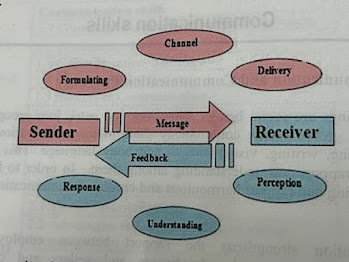Communication and Communication Process
The Communication is an art of transmitting information, ideas and attitudes from one person to another. Communication is the process of meaningful interaction among human beings.
Communication strengthens the rapport between employees and employers, Superiors and subordinates and sellers and customers. Effective communication facilitates the coordination and control, leading to enhanced productivity whereas ineffective communication results in conflicts, mismanagement, lower productivity, distrust among employees.
Communication Essence
- It is a two way process.
- It is a Personal process and Occurs between people. It aims at change in behavior and also to influence others.
- It involves expression of thoughts and emotions through words and actions. It is a tool for controlling and motivating people.
- It is a social and emotional process.
Communication: The Flow
In the process of communication, information flows from sender to receiver.
The message in the form of ideas, thoughts, feelings, opinions is transmitted between two or more people, which aim at creating a shared understanding.
Thus Communication is the bridge that forms the basis of understanding among the members of the organization.
Effective communication means the message is understood in the same sense in which it has been communicated.
The communication is a dynamic process which begins by encoding of ideas through the medium of language by the sender who then transmits the message through a channel to the receiver, who decodes the message and gives the feedback in the form of some message or signal within the given time frame.
Sender
The sender or the communicator is the person who initiates the conversation and encodes the message or the idea that he intends to convey it to others.
Encoding
In encoding process the sender uses words or non-verbal elements like symbols, signs, gestures etc. to translate the information into a message.
The sender’s knowledge, skills, perception, background, competencies etc has a great impact on the success of the message.
Message
Once the encoding is finished, the sender is ready with the message which he intends to convey. The message can be written, oral and symbolic or non-verbal such as gestures, silence, sigh, sounds etc. or any other signal that triggers the response of a receiver.
Communication Channel
The Sender chooses the medium or channel through which he can convey his message to the receiver.
The choice of medium depends on the interpersonal relationships between the sender and the receiver and also on the urgency of the message being sent. Oral, virtual, written, sound, gesture etc. are some of the commonly used communication channels.
Receiver
The receiver is the person to whom the message is delivered. He tries to comprehend it.
The degree to which the receiver decodes the message depends on his knowledge of the subject matter, experience, trust and relationship with the sender.
Decoding
The receiver interprets the sender’s message and tries to understand is called as decoding.
An effective communication occurs only if the receiver understands the message in exactly the same way as it was intended by the sender.
Feedback
The Feedback is the final step of the Communication process. Feedback reveals whether the receiver has received the message and interpreted it correctly as it was intended by the sender.
The response of the receiver can be verbal or non-verbal.





No comments:
Post a Comment